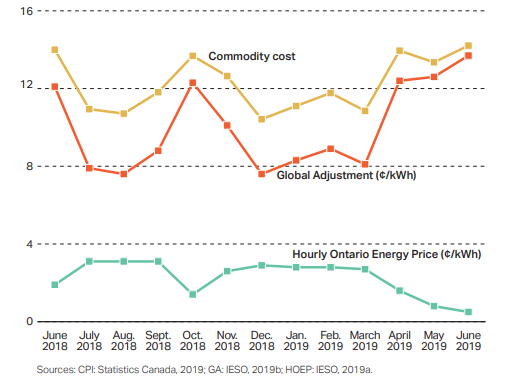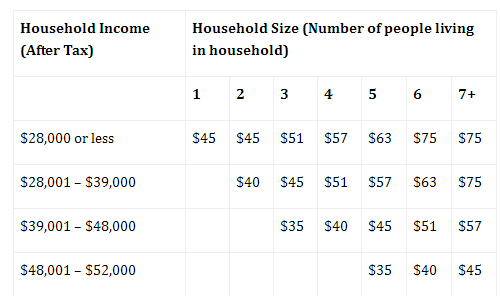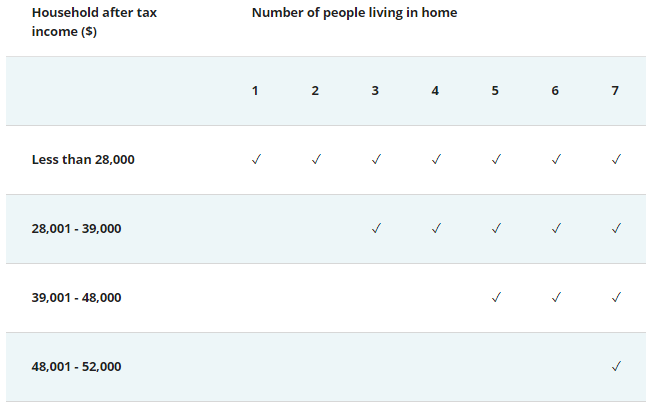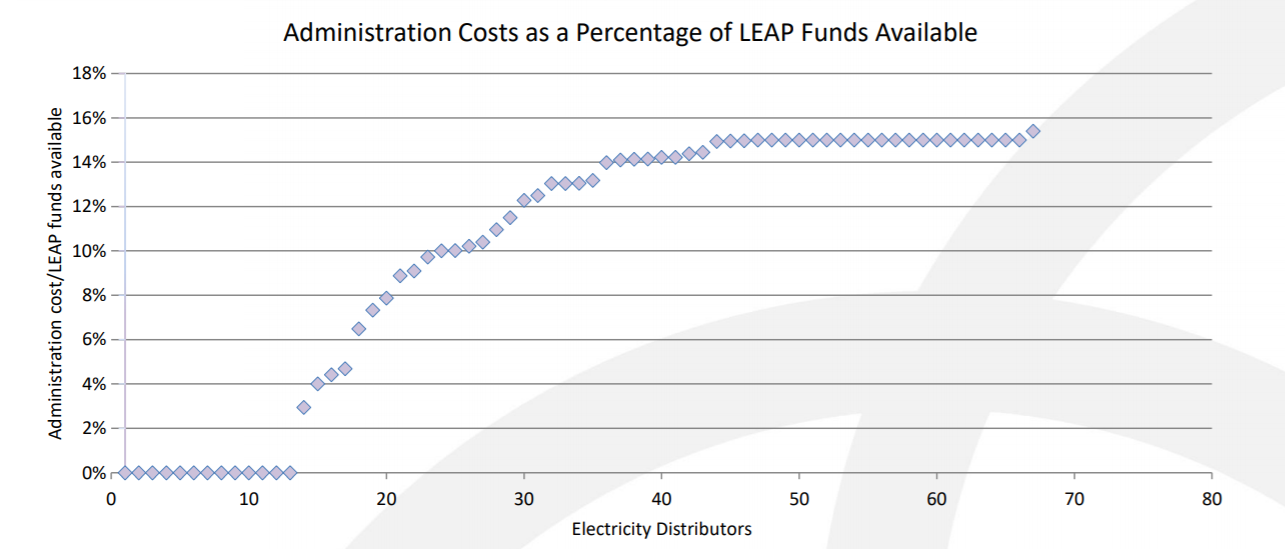Reforming Support Programs to Cut Hydro Costs
By Erik De Lorenzi
Going into the 2018 election, 61% of Ontarians said that hydro rates would impact their vote. The Progressive Conservative platform seized on this consensus by committing to reduce rates by 12%. Since assuming power, the Ford government has aimed squarely at the cost of electricity and launched multiple initiatives designed to lower rates, including but not limited to the repeal of the Green Energy Act, scrapping of conservation programs, and the cancellation of 758 renewable generation contracts. Despite these efforts, the total cost of electricity increased by 1.4% between June 2018 and June 2019.

For the immediate future, the government has chosen to continue to subsidize bills primarily through the Fair Hydro Plan. However, the Ontario government also has several permanent electricity subsidy programs that have received little attention in recent energy policy discussions. Are these permanent subsidies structured in the most effective way possible? Do they deliver real relief for those who need help the most? Can re-evaluating these programs help the government meet their 12% commitment for low-income Ontarians?
A Patchwork System
Aside from the temporary Fair Hydro Plan, Ontario has 5 main programs that are designed to assist households with the cost of electricity:
- the Ontario Electricity Support Program (OESP)
- the Low-Income Energy Assistance Program (LEAP)
- the Ontario Energy and Property Tax Credit (OEPTC)
- the Community Homelessness Prevention Initiative (CPHI)
- the Northern Ontario Energy Credit (NOEC)
While they serve similar groups of people, the programs are not integrated with one another and are often administered by separate agencies. As one example, LEAP is run by 156 separate, regional social service agencies. This patchwork structure is not a recipe for a service-friendly and administratively efficient system.
The LEAP and OESP programs are the most well known and broadly applicable programs of the five. To improve Ontario’s low-income subsidy system , we must start with these programs.
Ontario Electricity Support Program (OESP):
Established in 2014, the OESP provides monthly credits to roughly 200,000 low-income Ontario households ranging from $45-$113 a month. The program was developed by and is now administered through the Ontario Energy Board (OEB) and costs the government approximately $130M a year. Originally, the program was funded by a charge on all Ontario electricity bills . However, the Wynne government moved the program onto the tax base as part of their expansive Fair Hydro Plan and also increased the subsidy by 50% to their current levels. In order to receive the OESP credit, households must be deemed low-income (see Figure 2) and must self apply.

Low-Income Energy Assistance Program (LEAP):
In many cases, monthly supports from OESP may not be enough or alternatively, families do not know about the program and therefore do not apply. In those situations, low-income households may be faced with bills in hand that they cannot pay. LEAP addresses the challenge of continued payment difficulties through providing a one-time support package to ratepayers in arrears with their local distribution company. Established by the Dalton McGuinty government in 2011 as a fixed charge to ratepayers, LEAP provides a maximum annual payment of up to $600 for electricity customers and $500 for natural gas customers. In 2018, LEAP granted about $7.3M in relief to approximately 17,000 households.
Essentially, LEAP is a one-time program designed for those in immediate need, whereas the OESP is a longer term, monthly payment designed to deliver consistent relief for low-income families.
LEAP’s delivery relies heavily on cooperation between local distribution companies and social service agencies. Across Ontario, 156 different social service agencies receive applications, conduct initial screening interviews for eligibility, and assign cases to a further 68 lead agencies who administer in-person interviews and grant final approval. In both cases, LEAP and OESP cap out at $52,000 of household income.

Failing to Energize Ontarians In Need
There are three primary problems with both the OESP and LEAP: low uptake, administrative inefficiencies, and financing challenges.
Low Uptake:
OESP and LEAP have fallen short of their relatively modest enrollment expectations which were determined during their respective developments . Initial OEB forecasts in 2014 predicted that some 570,000 households would consistently benefit from the OESP at a total annual cost to Ontario of $175M-$225M (OESP was half as generous then). In the five ensuing years, the credit has seldom provided relief to more than an average of 200,000 households a month.
The potential pool of recipients is much larger than that. When measuring after-tax household income in Ontario, as both programs do, more than 60% of Ontario’s households fall within the eligible income range of both programs (see Figure 2 and 3).
Though these households qualify for the OESP, they may not qualify for LEAP as they must also be in arrears on their electricity bill. However, for illustrative purposes scholars have calculated that between 20%-25% (roughly 225,000 households) of Hydro One’s primarily rural customers consistently face average arrears of $1,300. This study was conducted prior to the Fair Hydro Plan but, given that LEAP only assists 17,000 households a year, it is safe to say that there are many more customers in arrears than the program helps.
Low uptake is not a challenge unique to Ontario. Multiple studies focused on US energy support programs have reached similar conclusions that program awareness is exceptionally low among the broader population and even worse within low-income groups. Indeed, across 24 surveyed state and federal low-income efficiency programs the average participation rate was a mere 2.6%.
Administrative Inefficiencies:
Despite the qualifying income levels being the same, an applicant must apply to each program separately. This is true even though both programs also require a copy of recent electricity bills in order to qualify a household. Generally, if you are eligible for LEAP because you are in arrears, there is almost no way you would not be eligible for the OESP if you applied.
Worse yet, the application processes themselves are burdensome. To qualify for LEAP an applicant must first apply to a regional social service agency (e.g., United Way) to arrange a pre-screening phone interview. Once their income and household eligibility are confirmed, an in-person interview, likely with a different agency wherein all household members are supposed to attend, will be organized. At the end of this process, 63% of rejections are issued due to insufficient documentation being provided – documentation which is generally already possessed by multiple government or quasi-governmental entities. To suggest this is not a service-friendly approach would be an understatement.
Financially, the administration of the programs is very different. Administrative expenses incurred by the OEB in its management of the OESP contributed to less than 2% of program-related costs. However, for LEAP, each application cost the government $56.13 to process. For dozens of local distribution companies, LEAP’s administration requirements cost them almost 16% of their entire LEAP budget.
Financing Structure:
While the OESP was moved onto the tax base by the Wynne government, LEAP continues to be funded by electricity ratepayers. At an annual cost of $7M, LEAP’s contribution to the cost of electricity bills is at most a rounding error. Despite the small cost of the program, it is financed in a bizarre way.
At the start of every year, local distribution companies are given an envelope of LEAP funding to administer to customers who qualify. When that money is gone, no more funds are given out – even if a neighbouring local distribution company has not used a single dollar of their allocation. In 2014 and 2015, 50% of distributors ran out of their annual allocation by June. That has since improved to August, meaning anyone who goes into arrears between August and December has no recourse from government.
Exploring Solutions
While the challenges with OESP and LEAP are fierce, the Ford government has several options that could potentially improve the existing patchwork of subsidies.
Enrollment Mechanism:
There are two broad approaches for eligible applicants to receive supports: either through an application-based system or via automatic enrollment. As noted, the existing intake process produces a <10% participation rate for OESP and a considerably lower rate for LEAP.
In shifting towards an automatic enrollment mechanism, program participation would rise rapidly. Automatic enrollment could be achieved by extending these benefits to recipients of other income supports like Ontario Works (OW) or the Ontario Disability Support Program (ODSP).
For illustrative purposes, if the OESP was extended to all 377,600 monthly ODSP recipients, total OESP enrollment would increase by almost 90%. In pairing the automatic enrollment of OW and ODSP recipients alongside the existing application-based system for those not receiving social assistance, the government would be well-positioned to realize the OEB’s initial enrollment targets.
If the government expanded the OESP to reach the OEB’s initial targets of 570,000 monthly recipients, the total annual program cost would rise to over $370M a year from its current $130M in 2018.[1] For a government actively pursuing a 12% province-wide rate reduction, increased subsidies could help them argue success. At the same time, the financial pressures would increase on the government’s fiscal plan and the path to budget balance would become harder. Automatic enrollment, therefore, could wait until the government balances the budget which would coincide well with the planned expiry of the current Fair Hydro Plan subsidy.
Politically, automatic enrollment would give the governing party a distinct opportunity to tackle electricity costs and commit to anti-poverty measures. Given its progressive nature, this policy approach would be inherently difficult for opposition parties to attack and would be consistent with the government’s goal of giving money back to Ontarians to lower the cost of living. If the government does not take up this idea, Ontario’s opposition parties could easily push for the change themselves.
Program Administration:
The government should seriously consider bringing the OESP and LEAP together into one program. Ultimately, the LEAP program as we know it today would cease to exist.
With both programs combined under one roof, the government would be able to immediately address the challenge of households not being cross-qualified for both programs at the same time. Those who are in arrears could be fast-tracked into the program and automatically enrolled to receive the longer term OESP subsidy. Combining the programs would also offer a workaround to any privacy-related barriers that prevent the sharing of personal information across agencies and force multiple applications to be filled out.
The government could transfer the $7 million a year cost to the rate base, in order to align with the OESP’s funding model, and alleviate local distribution companies and social service entities of another administrative burden, thereby saving them precious dollars and time.
Further, if increasing uptake is a policy priority the government could explore moving the new program to be under the Ministry of Children, Community and Social Services in order to harmonize it with other social service programs. Ultimately, having a single administrator would offer the additional benefit of reducing complexity for applicants and simplifying the subsidy process.
Conclusion:
Given the government’s priorities of improving service delivery, saving administrative dollars, and lowering electricity bills by 12%, the solution that should be considered would be one single electricity subsidy program. That program would be centralized within government and funded through the tax base.
In addition, if increased uptake is desired, the government could create an automatic enrollment system harmonized with other non-energy income support programs. However, that policy move would come with substantial new costs and may need to be deferred until after the budget is balanced and the Fair Hydro Plan expires.
[1] OEB Annual Report (2018). https://www.oeb.ca/sites/default/files/OEB_AnnualReport_2017-18.pdf